Last Updated on May 4, 2025 by Michelle
Ever since I started milling my own flour my basement is overrun with wheat berries. And whenever I show my wheat berry stash over on Instagram, I inevitably get lots of questions about how to store wheat berries. So let’s answer all the burning questions.
Given that fresh milled flour is becoming very popular, that means that lots of people are also stocking up on wheat berries. But whenever I see someone freeze wheat berries or use tiny, expensive mylar bags to store their wheat berries I cringe. There’s a better way. So let’s get you on your way to storing wheat berries–the right way.
What are wheat berries and why should I store them?
Wheat berries are, quite literally, the fruit of wheat. They’re the part of wheat that you have leftover when you remove the outer hull. If you were to walk into a wheat field, grab a stalk of wheat, and shake it, wheat berries would fall out. In very simple terms, wheat berries are un-milled flour.
When you mill wheat berries, they become flour. But the beauty of wheat berries is that in their whole, un-milled state they last, basically, indefinitely. Unlike flour, that easily and quickly goes rancid. Well, real flour, that is. You see, store bought flours have been heated, sifted, and processed until it’s no longer real flour. It’s dead. So therefore it lasts longer than real flour should, because anything nutritious (including the healthy oils and vitamins) has been sifted or heated out of the final product.
When we mill our own flour from whole wheat berries, we can keep all the nutrients that store bought flour leaves out. But that means that real flour, fresh milled flour, goes bad more quickly. Which is why we store wheat berries in their whole form, rather than milling and storing flour.
So we buy grain mills, store wheat berries, and mill our own flour.
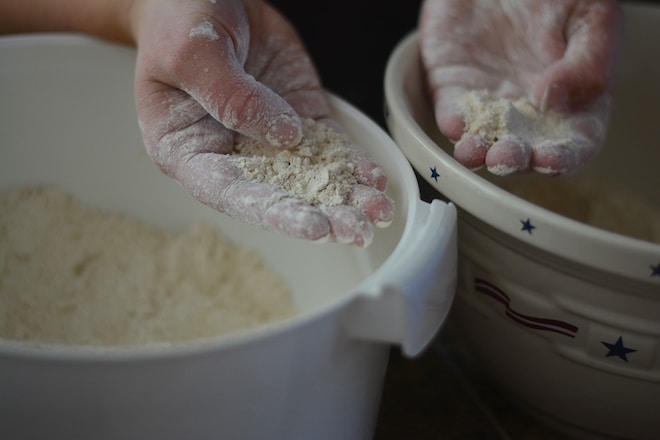
How NOT to store wheat berries (wheat berry storage mistakes)
For starters, let’s cover ways you shouldn’t store wheat berries. I’ve seen enough really bad advice out there to know that this section is desperately needed.
- Don’t waste your money using mylar bags if you’re using your wheat berries frequently. Wheat berries, in their natural, un-milled, whole state last literally indefinitely, and unless you’re planning to store your wheat berries for a very long time untouched (for instance, if you’re building an emergency supply kit), mylar bags are just going to be a waste of time and money.
- Along the same lines, please don’t bother wasting money on oxygen absorbers unless you’re storing wheat berries in small containers for long, long periods of time. Throwing an oxygen absorber into a jar that you’re going to open in the near future defeats the purpose entirely. As soon as that absorber is exposed to oxygen, it’s void. Useless. These are only needed or helpful if you’re not opening your container of wheat berries AT ALL.
- Don’t store large quantities of wheat berries in glass or other clear containers for extended periods of time. I know, opaque containers aren’t as pretty as glass or clear ones, but for long-term storage, you want to minimize the amount of light the wheat berries are exposed to.
- Please, please don’t freeze your wheat berries before storing them. Read why below.

Should I freeze wheat berries before storage?
I know that freezing wheat berries before storing them is popular advice, and seems to make sense on the surface. The idea is to kill any bugs that might be present in your wheat.
But #1, if you’re worried about bugs in your wheat–frankly–find a better, cleaner, more reliable source for wheat berries. And #2, freezing introduces moisture into your wheat berries. This is really bad for a few reasons. It’s easy to destroy your grain mill with moisturized wheat berries (a very costly mistake!). It’s easy for moist wheat berries to grow mold or harbor bacteria in storage. And, finally, it just plain messes with your flour. Once wheat berries are introduced to moisture (like a freezer!), it’s hard for the average person like you an I (without fancy equipment) to monitor moisture levels. Wheat berries with messed up moisture levels=flour with messed up moisture levels. Which then = inconstant results with bread and baked goods made with that flour. Farmers carefully monitor the moisture of wheat berries before they sell them, and introducing your wheat berries to your freezer ruins the carefully balanced moisture levels of the wheat.
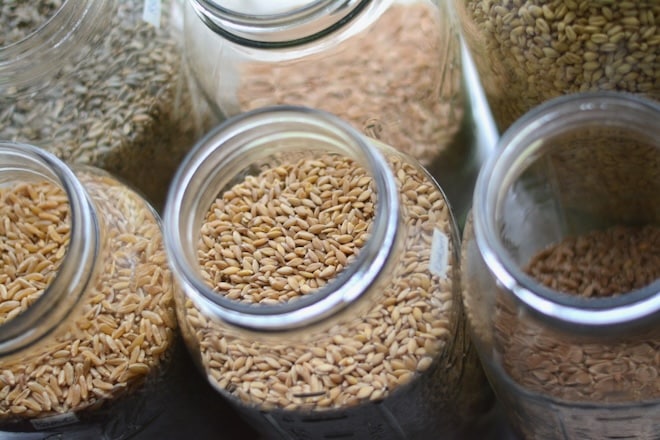
The effect of freezing wheat berries
To further prove that freezing wheat berries isn’t a good idea, it’s also worth noting that average freezer temperatures will only possibly kill already live pests, not eggs, larva or any other form of pest. This source recommends freezing, thawing, and refreezing your wheat berries for several cycles if you wanted to make sure any eggs that might be present in your wheat are dead. Even then, even if there were eggs in your wheat, there’s still a very good chance they’d live through your freezing-and-thawing games anyway. In fact, it’s more commonly advised to use heat of around 140 consistent degrees to kill pest eggs, not cold temperatures.
Not to mention that introducing wheat berries to very cold temperatures tends to damage the protein structures in the wheat. The protein is what allows gluten to develop in breads, so another way of wording that is that there’s a good chance freezing your wheat berries will weaken the gluten in your breads. Making bread with fresh flour has enough obstacles on its own, we don’t need to add lower gluten structure, flour with inconsistent and wrong moisture levels, and possibly mold and fungus to boot. Read more about freezing wheat berries for storage and how it impacts gluten structure in this study.
Not to mention freezing your wheat berries just. isn’t. needed.
Please. Don’t freeze your wheat berries.
How to store wheat berries long term
Storing wheat berries long-term is really simple. You’ll need a few supplies to get started, then you’re off to the races;
- 5-gallon buckets (or other opaque, air-tight containers)
- High-quality lids with seals (I personally can’t imagine how I ever stored wheat berries without these fancy lids!)
- Shelves or something else to keep your buckets off the floor + organized
- Wheat berries to actually store
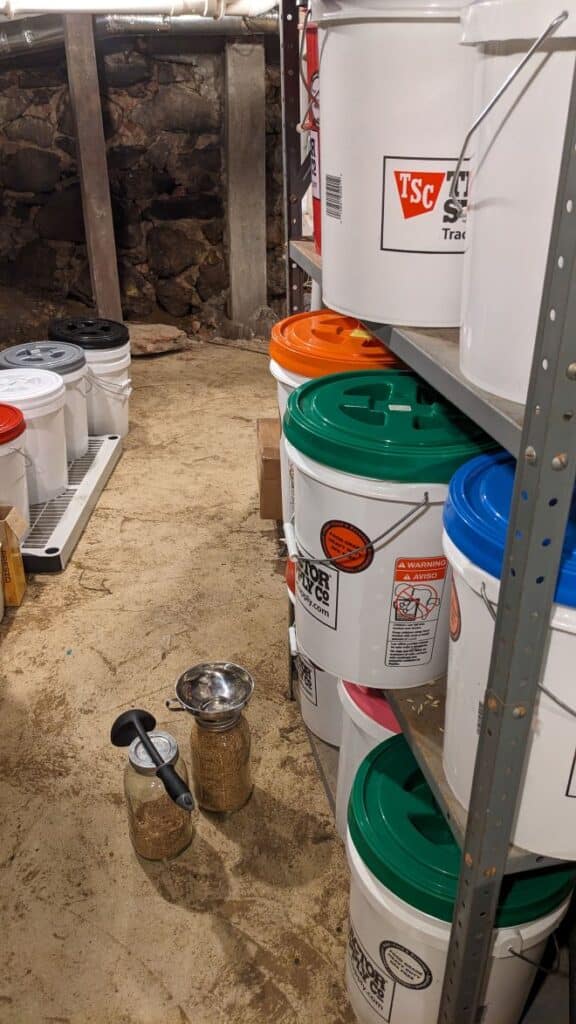
Storing wheat berries for a long time all starts with sourcing high-quality wheat berries. You’re far less likely to get bugs or run into any other issues if you’re ordering wheat berries from a source you trust. I order most of my grains in bulk from Azure standard and I have yet to have an issue. I’ve also heard good things about this brand that you can order right from Amazon. If you happen to have a local wheat farmer, even better. Ask to visit their operation and ask questions about their process.
When I get home with my bulk wheat berries, I simply pour them into a clean, dry 5-gallon bucket, make sure my lids are on and fitting properly, label them if needed, close ’em up, and forget about them until I need to refill my small jars that I keep upstairs. I do make sure I dump out and use any older wheat berries I have left in a bucket before covering up older ones with newer ones. I truly think that being careful to rotate my wheat berries and use older ones first has been tremendously helpful in preventing any issues.
If you don’t want to invest in sealed, air-tight lids just yet, generic bucket lids can be used, especially for shorter periods of time. I do have more peace of mind knowing that all my bucket lids have seals, though.
Essentially if your wheat berries are in a cool, dark place, in an airtight container, you’re golden.

Tips on how to store wheat berries
I’ve been storing wheat berries pest-free for just about a decade now. Here are my tried-and-true tips for safely storing wheat berries.
- Rotate your wheat berries to make sure you’re always using up older ones first. This is not only generally good practice, but can help your breads and baked goods turn out better, as well. Although wheat berries last basically forever under good conditions, some folks believe their bread turns out better when made with fresher wheat berries, as opposed to years-old ones.
- Check your supply regularly to make sure everything looks good. A simple glance around when you’re already in your wheat berry storage area can go a long way in preventing issues before they even start. Not to mention this will help you stay on top of your supply and not run out of anything or over order anything you don’t need yet.
- Use lids that don’t kill your fingers every time you open them. Seriously, using good lids that screw off instead of having to be literally pried off (ouch, we’ve all been there!), has changed the game for me.
- Store your containers off the floor whenever possible to avoid moisture from the floor seeping into your buckets.
- 40-60 degrees F is the ideal temperature for storing wheat berries long-term, but don’t stress if you can’t store them in exactly that range. Just do your best and keep them in a place that makes the most sense for you. Our dirt-floor basement is always dark and cool, so that’s the perfect place for us.
- Finally, store wheat berries you actually want to use. Stocking up and storing wheat is great, but only if it’s practical. If you’re stuck with 50 pounds of something you’re not going to use, well, you’ll just end up frustrated. I encourage everyone to purchase small amounts of new-to-them-grains first, just to make sure they like the texture, flavor, and overall performance of the grain before they stock up on it.
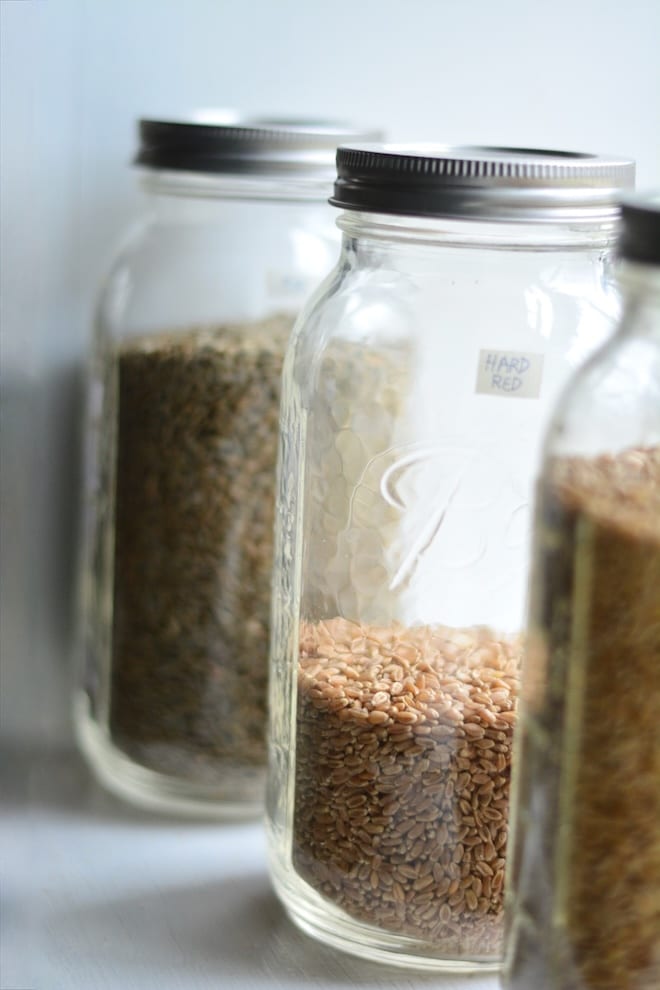
How to store wheat berries short term
If you’re not looking to buy wheat berries in bulk, storing them can be as simple as using Tupperware or mason jars. While we don’t want light to corrode our wheat berries when we’re looking to keep them fresh for long periods of time, it’s ok to keep wheat in glass or clear plastic for shorter lengths of time.
In fact, I store a smaller amount of basically every type of wheat berry I own in glass mason jars in my kitchen. I refill them from my basement-bucket stash when they run out. I’m not worried about the small amount of wheat berries I store in my kitchen being exposed to light and heat because I’ll use them up first and quickly.
How long do wheat berries last?
This question is pretty funny if you really think about it. The reason we have ancient grains still today is because wheat berries essentially last forever. For instance, Einkorn is thought to be one of the first domestically cultivated crops. We have it today because archaeologists found Einkorn grains at ancient dig sites and cultivated it in modern climates. We have Einkorn today, essentially, because wheat berries last forever.
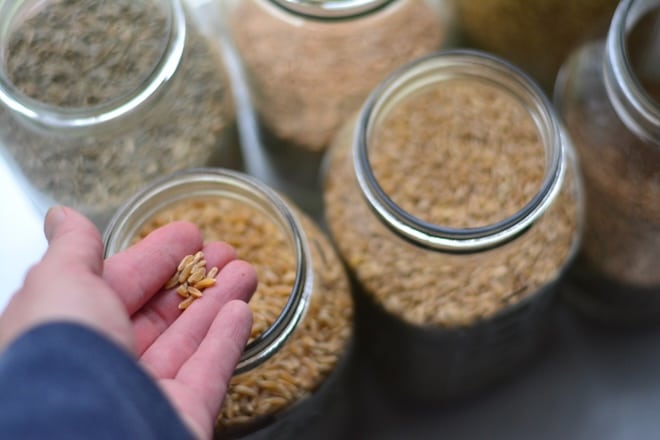
Wheat berries can, over time, lose some of their, shall we say, vibrance? And some folks claim that older grains can be harder to make bread with. Grains that have been stored for a significant amount of time may have less protein or gluten potential versus grains harvested more recently.
But if stored properly in a cool, dry, dark environment, wheat berries should last, no problem, over 30 years and be perfectly fine to bake with.
Will 50 pounds of wheat berries fit in a 5 gallon bucket?
In my experience I can fit 30-35 pounds of wheat berries in each 5-gallon bucket. Which is rather unfortunate if you (like me) order them in 50-pound quantities. I usually just try to have a few extra (empty) buckets and lids on hand. I then use the extra buckets as “overflow” where I can store the extra 15-20 pounds of wheat berries that don’t fit into their “base” bucket. I’ll use up the extra bucket’s worth first so I can free the bucket up for my next order of wheat berries.
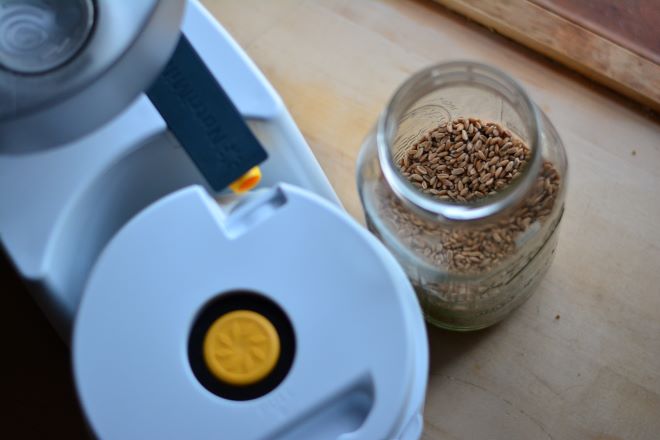
Should I wash wheat berries before milling them?
This one has a very short answer. No. Washing wheat berries before milling could have disastrous consequences. Trying to mill wet or moist wheat berries will gum up your mill and just isn’t necessary. Farmers clean wheat as well as they can before distribution so you don’t have to worry about it.
Do look through your wheat berries (especially right before milling) for any debris. Pebbles, stones, etc. that may have gotten through the farmer’s cleaning process. However, if you happen to notice very small, dark brown, round seeds in with your wheat berries, congrats! You most likely have some high-quality wheat berries on your hands. Those small seeds are Vetch seeds. They are one of the most common cover crops used in organic wheat farming to replenish the soil. They won’t harm your grain mill if they get through your inspection.
The only time I would rinse wheat berries before using them is if I was cooking them, not milling them.
How to know if wheat berries have gone bad
Like we’ve discussed, if stored properly most wheat berries won’t go bad. However, if your wheat berries weren’t dried properly before they got to you, or if moisture got into them in your care, they can go bad. You’ll notice an off color or smell if your wheat berries have gone bad. If they smell musty or oily, chances are moisture allowed mold or mildew to grow in your wheat.
More like how to store wheat berries:
- Wheat berries: everything you need to know
- Choosing the right wheat berries: a guide
- 5 benefits of milling your own flour
- Sourdough with fresh flour: what you need to know
Talk to me about how to store wheat berries…
If you have questions, leave a comment below. And please tag me on ig to show me your wheat berries, grain mills, how you store your wheat berries, etc., @souly.rested.
Enter to Win a Grain Mill!

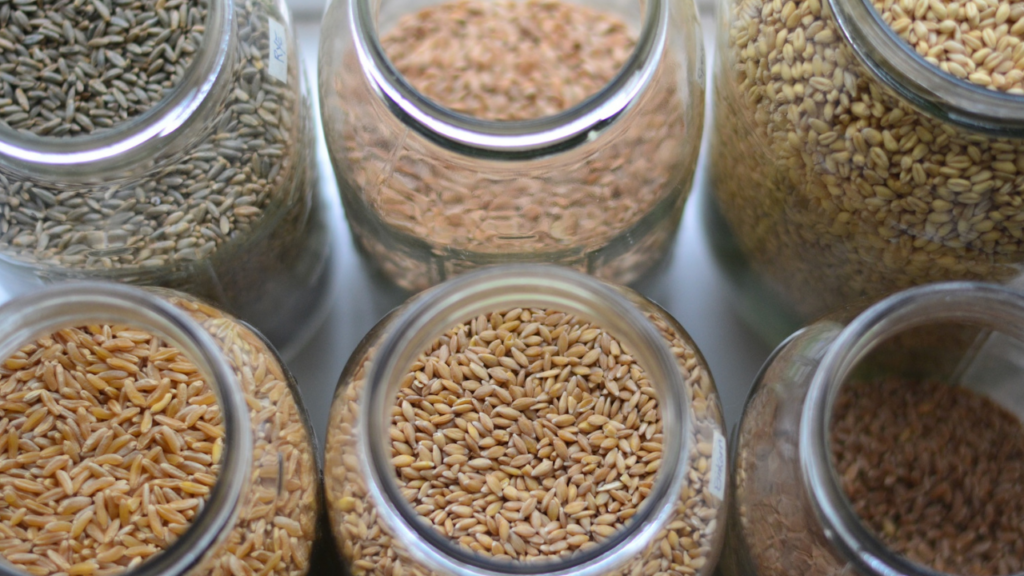
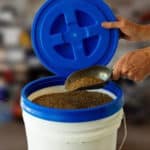

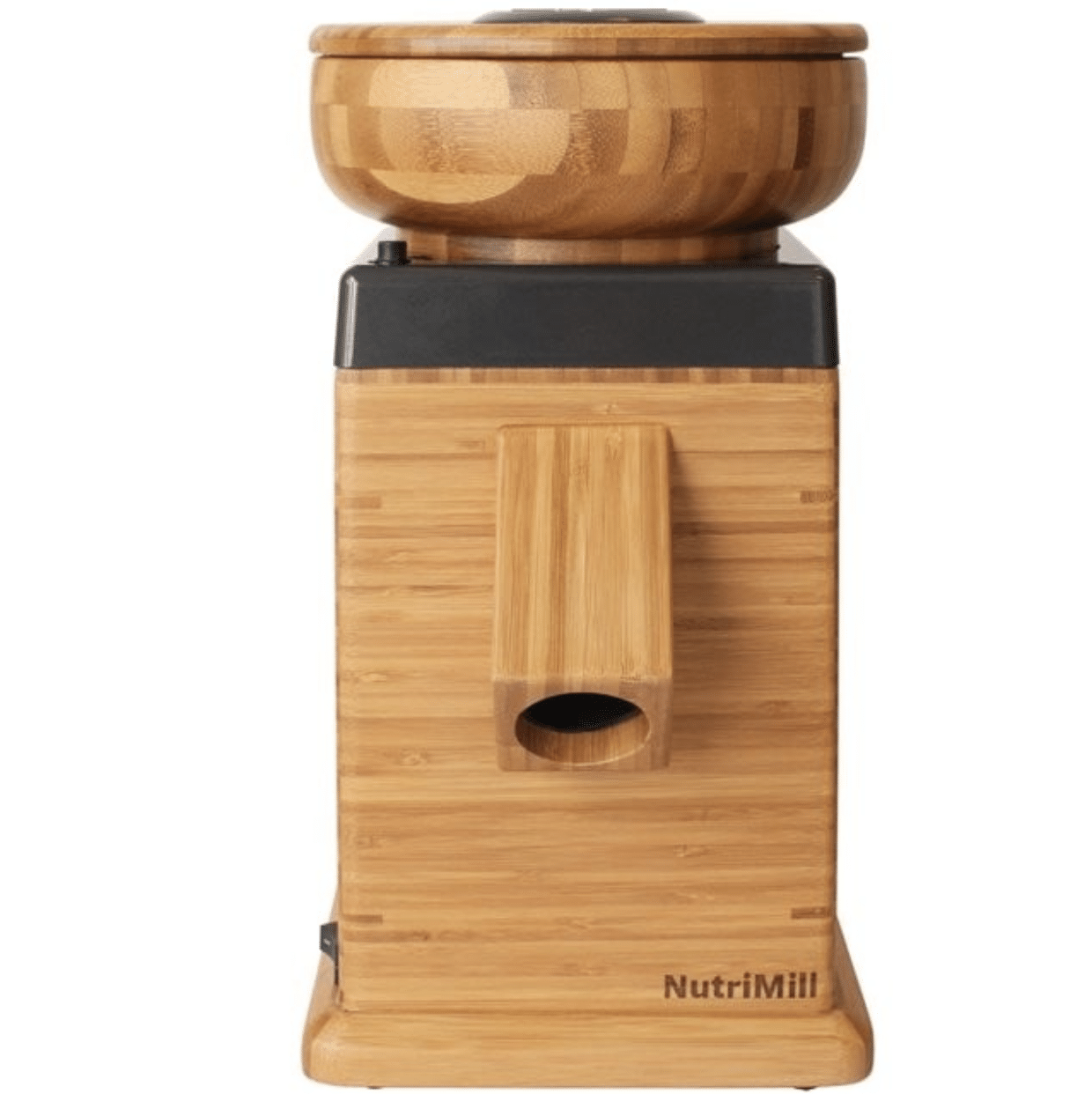

Magic hour is approaching! Good luck everyone!
Hi, I appreciated you good advice on storing wheat berries. I’m in Florida, in a small condo. We store the wheat berries in a food grade bucket in our dining room. I’ve been ordering from Azure Standard, love their products. But my last batch of winter red wheat, that has been stored for about 5 months, has weevils. I didn’t freeze them, or do anything but dump the bag into a clean bucket. Any suggestions? And the white soft wheat berries had these small round black things. Are these Vetch seeds? They feel more like round stones with a slightly pointed end. I soaked them in water, and they didn’t sprout or get softer.
Thanks for any advice,
Joyce
Hi Joyce, I’m so sorry you’ve had weevils get in your berries! I’ve never experienced this over the past 7+ years I’ve been storing grains and I’m sorry I don’t have advice on that for you. But yes, it definitely sounds like vetch seeds in your other berries.
How do I get your cook book?
right here: https://terrific-cherry-777.myflodesk.com/
I have wheat berries in the bags they come in… inside a 5 gallon food grade bucket with a gamma lid. Should I take them out of the original bags and why?
Hello, I just recently bought 25 lb bags sprouted wheat berries. Do these need to be dried or dehydrated in advance before long term storage? When I googled it previously it said to do that but it will take a while if I do and I dont know if its necessary.